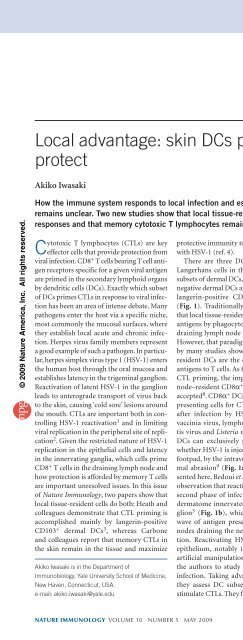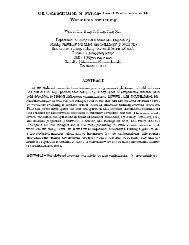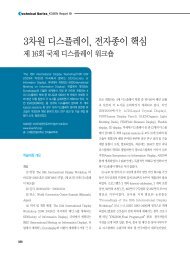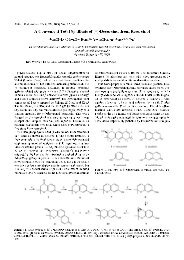Nature Immunology
Nature Immunology
Nature Immunology
You also want an ePaper? Increase the reach of your titles
YUMPU automatically turns print PDFs into web optimized ePapers that Google loves.
© 2009 <strong>Nature</strong> America, Inc. All rights reserved.<br />
Local advantage: skin DCs prime; skin memory T cells<br />
protect<br />
Akiko Iwasaki<br />
How the immune system responds to local infection and establishes protective immunity in susceptible tissues<br />
remains unclear. Two new studies show that local tissue-resident dendritic cells prime cytotoxic T lymphocyte<br />
responses and that memory cytotoxic T lymphocytes remain in the tissue to provide antiviral immunity.<br />
Cytotoxic T lymphocytes (CTLs) are key<br />
effector cells that provide protection from<br />
viral infection. CD8 + T cells bearing T cell antigen<br />
receptors specific for a given viral antigen<br />
are primed in the secondary lymphoid organs<br />
by dendritic cells (DCs). Exactly which subset<br />
of DCs primes CTLs in response to viral infection<br />
has been an area of intense debate. Many<br />
pathogens enter the host via a specific niche,<br />
most commonly the mucosal surfaces, where<br />
they establish local acute and chronic infection.<br />
Herpes virus family members represent<br />
a good example of such a pathogen. In particular,<br />
herpes simplex virus type 1 (HSV-1) enters<br />
the human host through the oral mucosa and<br />
establishes latency in the trigeminal ganglion.<br />
Reactivation of latent HSV-1 in the ganglion<br />
leads to anterograde transport of virus back<br />
to the skin, causing ‘cold sore’ lesions around<br />
the mouth. CTLs are important both in controlling<br />
HSV-1 reactivation1 and in limiting<br />
viral replication in the peripheral site of replication2<br />
. Given the restricted nature of HSV-1<br />
replication in the epithelial cells and latency<br />
in the innervating ganglia, which cells prime<br />
CD8 + T cells in the draining lymph node and<br />
how protection is afforded by memory T cells<br />
are important unresolved issues. In this issue<br />
of <strong>Nature</strong> <strong>Immunology</strong>, two papers show that<br />
local tissue-resident cells do both: Heath and<br />
colleagues demonstrate that CTL priming is<br />
accomplished mainly by langerin-positive<br />
CD103 + dermal DCs3 , whereas Carbone<br />
and colleagues report that memory CTLs in<br />
the skin remain in the tissue and maximize<br />
Akiko Iwasaki is in the Department of<br />
Immunobiology, Yale University School of Medicine,<br />
New Haven, Connecticut, USA.<br />
e-mail: akiko.iwasaki@yale.edu<br />
NewS AND vIewS<br />
protective immunity to subsequent challenge<br />
with HSV-1 (ref. 4).<br />
There are three DC subsets in the skin:<br />
Langerhans cells in the epidermis, and two<br />
subsets of dermal DCs, consisting of langerinnegative<br />
dermal DCs and the newly described<br />
langerin-positive CD103 + dermal DCs 5–7<br />
(Fig. 1). Traditionally, it has been thought<br />
that local tissue-resident DCs ingest microbial<br />
antigens by phagocytosis and migrate to the<br />
draining lymph node to prime naive T cells.<br />
However, that paradigm has been challenged<br />
by many studies showing that lymph noderesident<br />
DCs are the only cells that present<br />
antigens to T cells. As for the DCs involved in<br />
CTL priming, the importance of the lymph<br />
node–resident CD8α + DCs has become well<br />
accepted 8 . CD8α + DCs are the main antigenpresenting<br />
cells for CTLs that are generated<br />
after infection by HSV-1, influenza virus,<br />
vaccinia virus, lymphocytic choriomeningitis<br />
virus and Listeria monocytogenes. CD8α +<br />
DCs can exclusively prime CTL responses<br />
whether HSV-1 is injected by needle into the<br />
footpad, by the intravenous route or by dermal<br />
abrasion 9 (Fig. 1a). In their study presented<br />
here, Bedoui et al. make the intriguing<br />
observation that reactivating HSV-1 causes a<br />
second phase of infection of the entire skin<br />
dermatome innervated by the infected ganglion<br />
3 (Fig. 1b), which results in a second<br />
wave of antigen presentation in the lymph<br />
nodes draining the new site of viral replication.<br />
Reactivating HSV-1 replicates in the<br />
epithelium, notably in the absence of any<br />
artificial manipulation of the skin, allowing<br />
the authors to study the course of natural<br />
infection. Taking advantage of this system,<br />
they assess DC subsets for their ability to<br />
stimulate CTLs. They find that whereas cross-<br />
presentation of viral antigen during primary<br />
infection after scarification is mediated by the<br />
lymph node–resident CD8α + DCs 3,9 , antigen<br />
presentation after natural infection with HSV-1<br />
in the skin during recrudescence is handled<br />
almost exclusively by the CD103 + dermal DCs<br />
(Fig. 1b). These results are consistent with the<br />
fact that dermal DCs are the main antigen-<br />
presenting cells after natural infection of<br />
vaginal mucosa with HSV-2 (ref. 10) and are also<br />
supported by a study showing differences in the<br />
participation of migrant versus lymph node–<br />
resident DCs in CTL priming after natural<br />
mucosal infection versus skin abrasion with<br />
HSV-1, respectively 11 .<br />
Several intriguing questions arise from this<br />
study 3 . First, why are different DCs involved<br />
in CTL priming during the primary and secondary<br />
infection? Is it possible that scarification<br />
allows HSV-1 to be carried by the lymph,<br />
circumventing the requirement for presentation<br />
by migrant DCs? This is unlikely, as<br />
migrant DCs are still needed for the CD8α +<br />
DCs to prime CTL immunity after scarification<br />
9 , which indicates that even if direct entry<br />
of the virus into the lymph node does occur,<br />
it is insufficient for priming by CD8α + DCs.<br />
Because scarification causes considerable tissue<br />
damage, it is conceivable that the CD103 +<br />
dermal DC functions may be suppressed by<br />
tissue-derived factors, rendering them unable<br />
to prime CD8 + T cells. Langerin-positive dermal<br />
DCs are shown to be responsible for crosspresenting<br />
epidermally expressed self antigen 3<br />
and are required for contact-hypersensitivity<br />
responses 7 , which suggests that these cells are<br />
able to present a diverse set of antigens. In<br />
contrast, langerin-negative dermal DCs are<br />
the main antigen-presenting cell for CD4 +<br />
T cells after scarification-induced HSV-1<br />
nature immunology volume 10 number 5 may 2009 451















